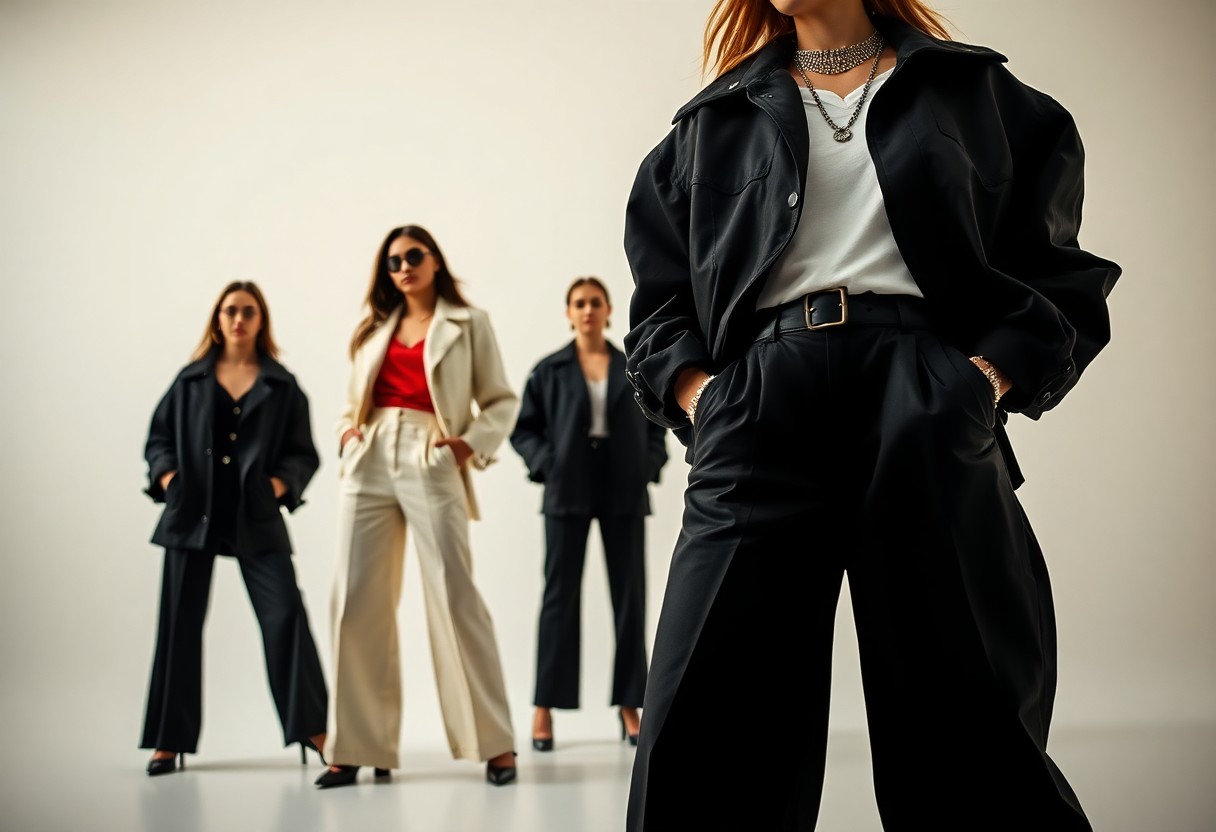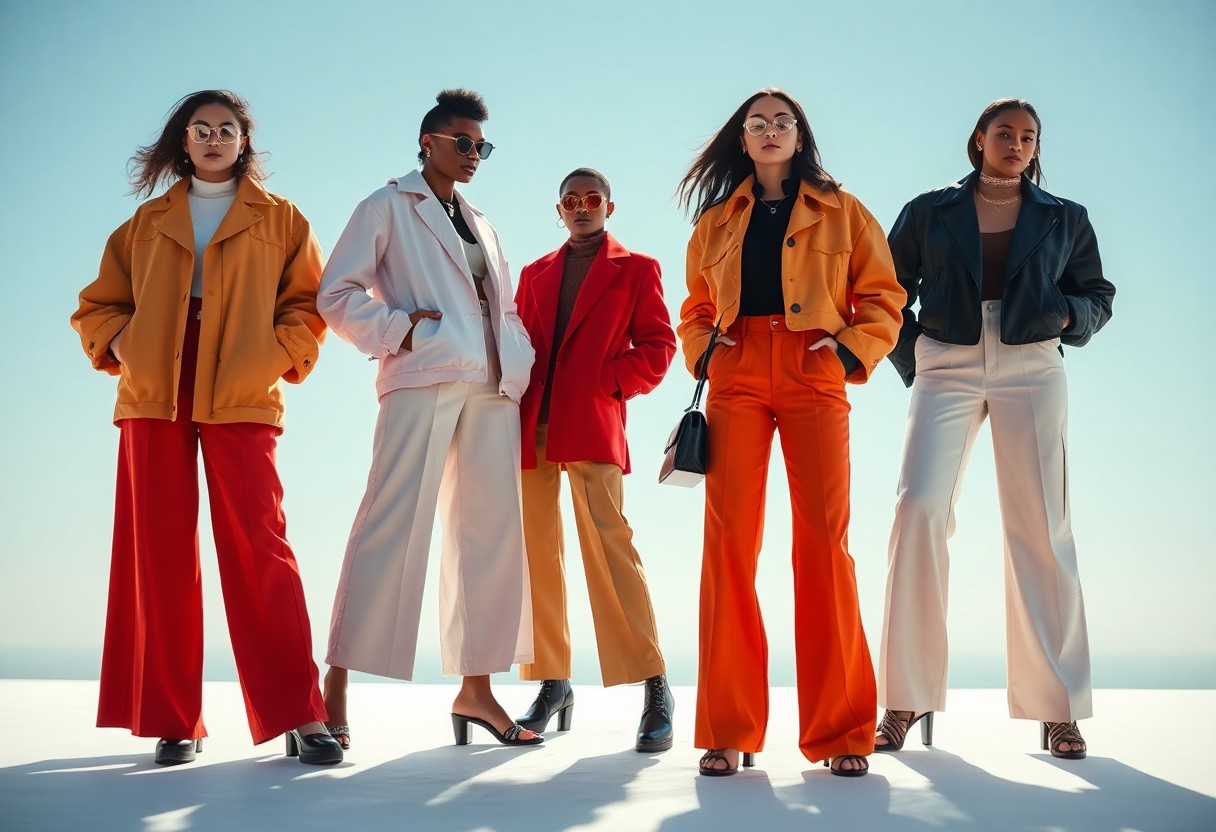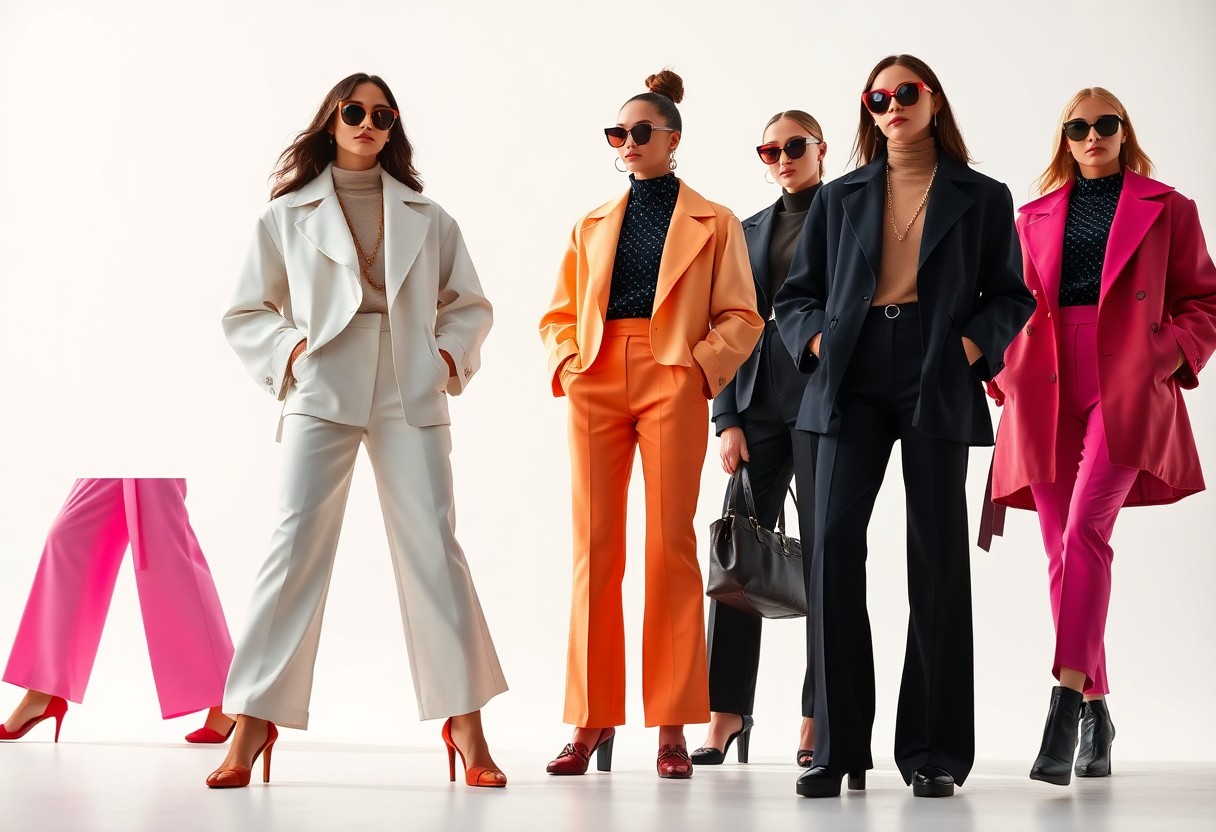1st Mar 2025
Exaggerated Proportions and Bold Silhouettes

It's time to embrace the world of exaggerated proportions and bold silhouettes in your fashion choices. These trends break away from traditional aesthetics, allowing you to express your individuality through dramatic shapes and striking designs. By incorporating such styles into your wardrobe, you can create a sense of confidence and uniqueness, making you stand out in any crowd. Whether you're dressing for an event or your everyday activities, understanding how to balance these bold elements will elevate your personal style to new heights.

Key Takeaways:
- Exaggerated proportions enhance visual interest and create a striking aesthetic, making garments stand out.
- Bold silhouettes contribute to a confident and modern look, allowing for creative expression in fashion design.
- This style can be versatile, adaptable to various forms of clothing, from casual wear to haute couture, making it appealing across different fashion audiences.
Understanding Exaggerated Proportions
To appreciate the appeal of exaggerated proportions in fashion, you must explore its rich historical context.
Historical Context of Fashion Trends
With each era in fashion, you can observe how changes in society have shaped design. For instance, the Baroque period celebrated opulence with wide silhouettes and layers, while the 1980s embraced boldness through oversized silhouettes that reflected the rise of personal expression and rebellion in culture.
Key Designers Influencing the Movement
Across the fashion spectrum, influential designers have pushed the boundaries of proportion to challenge norms.
Plus, notable figures like Thierry Mugler and Issey Miyake have orchestrated daring designs that emphasize dramatic shapes. Their work often incorporates larger-than-life elements, characteristic of the avant-garde movement, shifting the focus from the wearer’s body to the overall silhouette and message of the outfit.
Cultural Reflections in Fashion
With each collection that introduces exaggerated silhouettes, you can see the cultural narratives being woven into the fabric of society.
To understand these reflections, note how fashion acts as a mirror, often manifesting social movements and shifts in consciousness. For instance, the resurgence of bold, oversized garments may signify a collective shift towards embracing individuality and challenging traditional beauty standards. It encapsulates freedom and the rejection of conventional norms, allowing you to express your unique style.


The Role of Bold Silhouettes
Defining Silhouette in Fashion
Fashion encompasses a myriad of styles, and silhouettes are integral to conveying a designer's vision. A silhouette refers to the outline or shape of a garment and significantly influences how clothing interacts with the body. You will often find that bold silhouettes challenge conventional forms, allowing for creativity and self-expression within your wardrobe.
Examples of Iconic Bold Silhouettes
Bold silhouettes have left a profound mark on fashion history. Consider the dramatic shapes of the 1980s with oversized shoulders, or the romantic flow of voluminous skirts that define the gowns of designers like Alexander McQueen. Each piece not only turns heads but also invites you to rethink your own style narrative.
Iconic fashion pieces such as the trapeze dress of the 1950s or the power suit made famous by figures like Yves Saint Laurent emphasize the transformative power of bold designs. These silhouettes not only enhance your unique shape but also serve as statements that reflect cultural shifts, encouraging you to embrace confidence through exaggerated forms.
The Impact on Body Image Perception
Examples of bold silhouettes significantly affect how you perceive body image. The way clothing is structured can either empower or alienate, depending on societal standards. When adopting such styles, you may find yourself embracing a wider range of body types and aesthetics.
The influence of bold silhouettes extends beyond aesthetics; they can reshape your understanding of beauty standards. By championing diversity in body representation, these garments promote the message that all shapes are worthy of attention and style. Your choice to wear bold silhouettes may even inspire confidence in others, creating a ripple effect that celebrates individuality.

Materials and Fabrics
Despite the ever-changing fashion landscape, the choice of materials and fabrics remains a core aspect of creating exaggerated proportions and bold silhouettes. The right textiles not only influence the visual impact of your designs but also affect the overall wearability and comfort of the garments.
Innovations in Textile Technology
Innovations in textile technology have drastically altered the possibilities for fashion design, offering you materials that are lighter, stronger, and more versatile than ever before. Techniques such as 3D weaving and the development of sustainable, technical fabrics enable designers to create bold silhouettes while prioritizing both form and function.
Selecting the Right Fabrics
Between the myriad of choices available, selecting the right fabrics is crucial for achieving the desired style and silhouette. Each fabric carries its unique weight, drape, and texture, which directly influence how your designs will appear in reality.
Fabrics play a significant role in the success of your design. A heavy canvas will stand out and maintain structure, creating dramatic shapes, while lighter materials like chiffon may flow softly, adding layers and movement to your look. Understanding the properties of different textiles allows you to manipulate proportions effectively, leading to innovative styles that can catch the eye.
The Relationship between Fabric and Shape
Materials fundamentally shape the outcome of any design, impacting how garments fit and flow on the body.
The relationship between fabric and shape can define your entire collection. A structured material can enhance bold silhouettes, while delicate fabrics can offer an ethereal quality. It’s crucial to consider how weight, stretch, and texture contribute to the overall aesthetic, allowing you to control how your garments project strength or softness in visual form. By mastering this relationship, you elevate your designs to new heights, showcasing your artistic vision effectively.
Styling Exaggerated Proportions
How to Wear Exaggerated Styles
Your journey into bold fashion begins with understanding how to balance exaggerated styles. Above all, proportion is key; pair oversized pieces with more fitted items to create a harmonious silhouette. Experiment with layering, allowing the volume to stand out while maintaining overall shape. Tapered trousers can beautifully counterbalance a billowy top, ensuring you feel confident and chic.
Accessories that Complement Bold Silhouettes
Accessories can elevate your look when styling bold silhouettes. Accessories should serve to enhance, not compete with, your dramatic outfit choices.
A structured bag or statement jewelry can perfectly contrast your exaggerated proportions. Focus on minimalistic yet eye-catching pieces to maintain the outfit's overall impact. Additionally, consider footwear: a pair of sleek heels can be an excellent choice to elongate your legs, complementing those voluminous outfits and allowing you to stand tall with confidence.
Color and Pattern Considerations
On your quest to style exaggerated proportions, color and pattern play a pivotal role in defining your look. Employing bold hues can energize your ensemble, while considered patterns can create a captivating narrative.
Styling vibrant colors into your outfits can transform them from merely oversized to sensationally stylish. Opt for monochromatic looks for a streamlined approach, while mixing patterns can add a fun, adventurous element. Just be cautious with prints, as busy patterns can overwhelm your overall aesthetic if not thoughtfully chosen. Your goal should be to express your unique personality while feeling comfortable and confident in your bold choices.
The Influence of Art and Architecture
Once again, the realms of art and architecture have played a pivotal role in shaping contemporary fashion. Their influence can be seen in the bold silhouettes and exaggerated proportions that dominate the runway, challenging traditional aesthetics and encouraging innovation in design.
Inspirations from Modern Art
Before delving into the specifics, it's crucial to acknowledge how modern art movements have invigorated your fashion perspective. Abstract expressionism, pop art, and minimalism all serve as rich sources of inspiration, fueling designers’ creativity and igniting a dialogue between visual art and garment construction.
Architectural Elements in Fashion Design
Behind the scenes, architectural elements are seamlessly integrated into fashion design, offering structural integrity and innovative shapes. The influence of architects’ methodologies can guide you to appreciate the transformative power of garments that echo the lines, forms, and spatial concepts found in iconic buildings.
In addition to structural elements, materials and textures borrowed from architectural designs enable a tactile experience that elevates your clothing. The use of materials like concrete, glass, and metal in fashion enhances the sculptural quality of outfits, while techniques such as drapery and layering emulate the lines of renowned architectural works. This fusion not only emphasizes form but also invites viewers to see clothing as an extension of spatial storytelling.
Case Studies of Art-Inspired Collections
Against this backdrop of inspiration, you can look at specific collections that boldly blend art with fashion, showcasing the successful execution of these ideas. Here are notable case studies:
- Yves Saint Laurent: His iconic 1965 Mondrian dress revolutionized fashion by using graphic design elements, selling over 7,000 units in its first year.
- Isabel Marant: Inspired by Brutalism, her 2020 collection used stark fabrics and bold shapes, leading to a 35% increase in sales.
- Alexander McQueen: The 2003 "Irere" collection was a direct homage to Gothic architecture, receiving multiple awards and critical acclaim.
Another aspect to consider is how these collections reflect larger cultural themes and dialogues within art. For instance, the Yves Saint Laurent collection not only captivated the public but also ignited a conversation about the intertwining of artistic expression and wearable art, exemplifying how the marriage of art and fashion can lead to both artistic and commercial success. Your understanding of these collections helps you appreciate the broader context of design as a commentary on society, and not just as a visual spectacle.
Critique and Controversies
Not everyone agrees on the merits of exaggerated proportions and bold silhouettes in fashion.
The Debate on Wearability vs. Artistry
Any style that pushes boundaries often raises questions about its wearability versus its artistic value. Critics argue that while these avant-garde designs might be visually compelling, they often lack practicality, leaving you to ponder whether you would genuinely incorporate them into your wardrobe or simply appreciate them from afar.
Cultural Appropriation in Exaggeration Styles
Behind the bold lines and dynamic forms, there lies a significant conversation about cultural appropriation. This issue surfaces when designers borrow elements from various cultures without a proper understanding or respect for their origins, leading to accusations of exploitation rather than celebration.
Controversies around cultural appropriation in exaggeration styles are often complex. Many designers draw inspiration from diverse aesthetics, but without context, this can lead to misrepresentation. You may find that fashion pieces seemingly celebrate a culture, yet they risk trivializing practices and symbols that hold deep meaning. Understanding this delicate balance is imperative for you as a consumer, ensuring you appreciate these styles responsibly while being mindful of their roots.
Sustainability Concerns in Exaggerated Fashion
Fashion has increasingly come under fire for its environmental impact, particularly in exaggerated fashion. Fast fashion trends can amplify waste by prioritizing bold statements over sustainability.
Exaggeration in fashion often leads to a temporary allure, but it can result in significant environmental consequences. You may choose to support designs that emphasize sustainability, yet the surge in demand for these standout pieces can result in higher production rates, exacerbating waste and pollution. Understanding the sustainability landscape in this genre is crucial for making informed choices in your fashion purchases, aligning your style with your values.
Conclusion
With this in mind, embracing exaggerated proportions and bold silhouettes can transform your style, making a striking statement that reflects your personality. These design choices enhance your body shape and allow you to experiment with textures and colors that command attention. By incorporating these elements into your wardrobe, you elevate your fashion game, creating unique ensembles that stand out in any setting. Trust in the power of these trends to express your individuality and redefine your aesthetic appeal.
